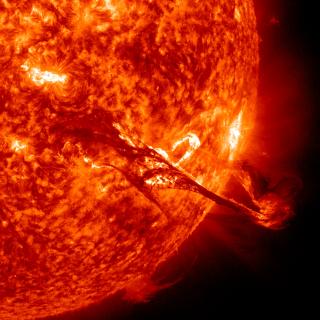Bibcode
Appourchaux, T.; Liewer, P.; Watt, M.; Alexander, D.; Andretta, V.; Auchère, F.; D'Arrigo, P.; Ayon, J.; Corbard, T.; Fineschi, S.; Finsterle, W.; Floyd, L.; Garbe, G.; Gizon, L.; Hassler, D.; Harra, L.; Kosovichev, A.; Leibacher, J.; Leipold, M.; Murphy, N.; Maksimovic, M.; Martinez-Pillet, V.; Matthews, B. S. A.; Mewaldt, R.; Moses, D.; Newmark, J.; Régnier, S.; Schmutz, W.; Socker, D.; Spadaro, D.; Stuttard, M.; Trosseille, C.; Ulrich, R.; Velli, M.; Vourlidas, A.; Wimmer-Schweingruber, C. R.; Zurbuchen, T.
Referencia bibliográfica
Experimental Astronomy, Volume 23, Issue 3, pp.1079-1117
Fecha de publicación:
3
2009
Revista
Número de citas
22
Número de citas referidas
17
Descripción
The POLAR Investigation of the Sun (POLARIS) mission uses a combination
of a gravity assist and solar sail propulsion to place a spacecraft in a
0.48 AU circular orbit around the Sun with an inclination of 75°
with respect to solar equator. This challenging orbit is made possible
by the challenging development of solar sail propulsion. This first
extended view of the high-latitude regions of the Sun will enable
crucial observations not possible from the ecliptic viewpoint or from
Solar Orbiter. While Solar Orbiter would give the first glimpse of the
high latitude magnetic field and flows to probe the solar dynamo, it
does not have sufficient viewing of the polar regions to achieve
POLARIS’s primary objective: determining the relation between the
magnetism and dynamics of the Sun’s polar regions and the solar
cycle.
Proyectos relacionados

Magnestismo Solar y Estelar
Los campos magnéticos son uno de los ingredientes fundamentales en la formación de estrellas y su evolución. En el nacimiento de una estrella, los campos magnéticos llegan a frenar su rotación durante el colapso de la nube molecular, y en el fin de la vida de una estrella, el magnetismo puede ser clave en la forma en la que se pierden las capas
Tobías
Felipe García